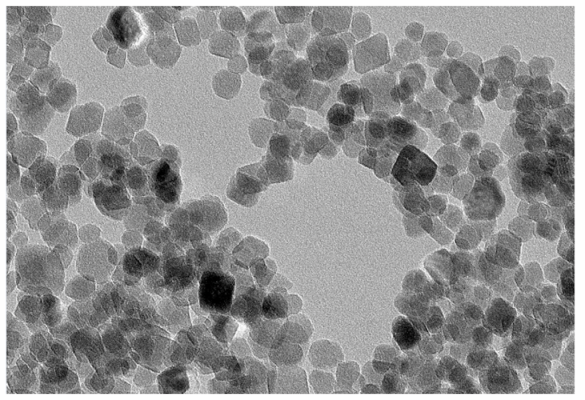Magnetic nanoparticles are particles with a size ranging from 1-100nm that possess the characteristics of nanoparticles, including quantum size effect, surface effect, and small size effect, as well as the properties of conventional nanomaterials. Among the various magnetic nanomaterials, magnetic Ferro ferric oxide (Fe3O4) nanoparticles have been extensively studied due to their remarkable features, such as surface effects and superparamagnetism. The surface modification of Fe3O4 can impart specific functions, such as adsorption and separation by an external magnetic field at room temperature. Therefore, magnetic Fe3O4 nanoparticles hold great potential for applications in biomedicine and sewage treatment. Furthermore, Fe3O4 nanoparticles have also found widespread use as catalyst supports.
Characteristic
The properties of magnetic nanomaterials are different from conventional magnetic materials due to the fact that the characteristic physical lengths associated with magnetism are exactly on the nanometer scale, such as: magnetic single domain size, superparamagnetic critical size, exchange interaction length, and electron average the free path is roughly in the order of 1-100nm. When the size of the magnetic body is equivalent to the physical length of these features, it will show abnormal magnetic properties.
Develop
Nano-characterization technology is a cross-integration technology of basic theoretical research and practical application of high-tech materials. It plays an important role in promoting the development of my country's high-tech materials industry. Its wider promotion and application in the country can accelerate the process of my country's high-tech materials research and make greater contributions to the development of my country's high-tech industries. Under the nano-characterization technology, the application of magnetic nano-materials is becoming more and more vigorous. For example, magnetic materials are closely related to informatization, automation, mechatronics, national defense, and all aspects of the national economy. Magnetic recording materials are still the main body of the information industry.
The Case
Magnetic fluids were first used in the aerospace industry and later in the civilian industry. This is a very typical application of nanoparticles. It is composed of superparamagnetic nanoparticles coated with surfactants and then dispersed in the base fluid. There are magnetic liquid companies in the United States, Britain, Japan, Russia and other countries. Magnetic liquids are widely used in rotary seals, such as dust-proof seals for disk drives, high-vacuum rotary seals, etc., as well as applications such as speakers, damping devices, and magnetic printing.
Magnetic nanoparticles as targeted drugs, cell separation and other medical applications are also a hot research topic in current biomedicine, and some have entered clinical trials.
The development of soft magnetic materials has gone through the process of crystalline state, amorphous state, and nano-microcrystalline state. Nano-made metal soft magnetic materials have excellent performance, high magnetic permeability, low loss, high saturation magnetization, and have been used in switching power supplies and transformers. Sensors, etc., can realize the miniaturization, light weight, high frequency and multi-function of devices, and are developing very rapidly.
Magnetoelectronic nanostructured devices are the most influential major achievements at the end of the 20th century. In addition to the giant magnetoresistance effect readout head, MRAM, and magnetic sensors, research on new devices such as all-metal transistors are in the ascendant. Magnetoelectronic has become a popular new discipline.
The application of magnetic nanomaterials can be described as involving various fields. It has broad application prospects in the fields of mechanics, electronics, optics, magnetism, chemistry and biology. The birth of nano science and technology will have a profound impact on human society. And it is possible to fundamentally solve many problems faced by human beings. In particular, major issues such as energy, human health and environmental protection. The main task at the beginning of the next century is to design various new materials and devices that conform to the century based on various novel physical and chemical properties of nanomaterials, and to modify traditional products through nanomaterial science and technology to increase their high-tech content and develop new products with nanostructures. Gratifying signs have appeared, and the foundation for forming a new economic growth point in the next century has been established. Magnetic nanomaterials will become a shining star in the field of nanomaterials science and play a pivotal role in various fields such as new materials, energy, information, and biomedicine.
Practical Application
Biomedicine
Magnetic polymer microspheres (also known as immunomagnetic microspheres) are biomedical materials prepared from magnetic nanoparticles and polymer skeletons. The polymer materials include polystyrene, silane, polyethylene, polyacrylic acid, glucose, gelatin, etc., the skeleton material is mainly a magnetic inorganic material. Fe3O4 is widely used in many fields of biomedicine, such as magnetic resonance imaging, magnetic separation, hyperthermia, Cell labeling and isolation and studies as enhancement contrast agents, contrast agents.
Water Treatment
The application of magnetic nanomaterials in wastewater removal is mainly as an adsorbent to absorb pollutants in water, including heavy metal ions and organic pollutants. Adsorbents commonly used in wastewater treatment have the disadvantages of low adsorption capacity, low treatment efficiency, low adsorption selectivity and non-recyclability. Compared with traditional adsorbents, magnetic Fe3O4 nanoparticles can selectively adsorb heavy metal ions. In addition, after the introduction of magnetism, the separation of the adsorbent becomes simple, and it can be easily separated from the solution with the help of an external magnetic field without secondary pollution.
Catalyst Carrier
Fe3O4 nanoparticles can be used as the catalyst carrier in the reaction, mainly used in the fields of chemical catalysis, photocatalysis and electrocatalysis. Due to the small size of Fe3O4 nanoparticles and poor surface smoothness, uneven atomic steps are formed, which increases the contact surface for chemical reactions. At the same time, the core-shell structure catalyst prepared by using Fe3O4 particles as the carrier and coating the catalyst components on the surface of the particles not only maintains the high catalytic performance of the catalyst, but also makes the catalyst easy to recycle. Therefore, Fe3O4 nanoparticles are widely used in the research of catalyst supports.

 Deutsch
Deutsch Русский
Русский Español
Español Français
Français 한국어
한국어 日本語
日本語
